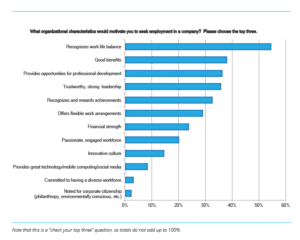What Organizational Values Do Job Seekers Value Most
(Editor’s Note: Today’s post is brought to you by our friends at SilkRoad, a leading global provider of cloud-based talent management solutions. SilkRoad was named one of the “Hot Vendors in Social Business” by Aragon Research for their Point collaboration solution. Check out their website for more information and please enjoy the post!)
Gallup reports that, despite the perceptions about the slow economy and high unemployment rate, 53% of small business owners find it difficult to find qualified candidates. The Society for Human Resource Management (SHRM) reported 66% of companies are having trouble finding workers. The market is definitely shifting.
That’s why it’s more important than ever to put some focused attention on your candidate experience. Honestly, businesses should have been paying attention to the candidate experience all along. Candidates are consumers. If you treat a candidate poorly, don’t expect them to buy your product or service. Don’t expect them to refer business to you.
So knowing what candidates want is valuable. Very valuable.
Our friends at SilkRoad just released a report “Sharpening Your Talent Acquisition Practices”. This report focuses on the candidate’s perspective. It’s really a great read and you can download it here.
The report goes into how candidates find job information, popular social media sites, and candidate’s pet peeves about recruitment. I won’t spoil the details but there is one graph that caught my eye.
What Organizational Characteristics Do Candidates Value Most?
Note that work/life balance and benefits were at the top of the list. They rated higher than professional development, leadership and recognition. I’ve seen this before in other surveys. It might be time to start facing some realities about the state of our current workforce.
I do understand some companies are still struggling. But we’ve also seen plenty of articles about corporate profits being at record highs. During the Great Recession, plenty of employees took pay cuts, shift cuts and benefit cuts, all to support the company. They feel it’s time for some payback.
And that “payback” doesn’t have to be expensive. Many work/life balance initiatives don’t cost the company anything. As I was reading this report, I was reminded of a conversation that I had with Tracy McCarthy SPHR, GPHR, chief human resources officer at SilkRoad, about their flexible time off policy. In a nutshell, SilkRoad gives employees time off as needed. I asked Tracy to share how the policy got started.
“In the spirit of treating employees like professional adults, SilkRoad adopted a flexible time off policy to support our flexible culture. Flexible PTO recognizes that employees have diverse needs for time off. This enables our employees to take what they need or want without the restrictions of traditional time off policies.
Now, it isn’t a complete ‘free for all’, we do have two simple rules when using the flexible paid time off (PTO). First, ensure that your coworkers and our customers are not negatively impacted by your time off. Second, communicate with your manager with as much advanced notice as possible and managers have the responsibility to say no if rule one is a concern.”
In case you’re wondering how the program is received (and I know you are), Tracy also told me how employees and managers reacted to the program.
“The first year we rolled out flexible PTO, it was met with some skepticism. Okay, a lot of skepticism. Once employees saw that it wasn’t smoke and mirrors and the control and responsibility was in their hands, they have embraced it. One thing that has pleasantly surprised many managers is the rare occasion of abuse. I think they expected more and it didn’t happen. So rather than punish all employees for the abuse of a few, we deal with the rule one breakers and help them understand the importance of responsible flexibility. Flexible PTO is the new normal at SilkRoad.”
This is a perfect example of creating a new way of doing business that benefits employees, managers and the company as a whole. I believe when we start talking about the candidate experience or employee engagement, we will have to think beyond policies and potlucks. If we really want to transform the workplace, we have to treat employees like adults. That means stop creating unnecessary policies, use common sense, and hold people accountable.
At some point in the not-too-distant future, candidates will be in the driver’s seat when it comes to the recruiting process. If they aren’t already. Companies always like feeling they’re in control of the process but, truth be told, sometimes they’re not. Now is the time for companies to decide – do you want to build a recruiting process that attracts candidates or look longer and harder to find talent?
Be sure to check out the other great information in SilkRoad’s “Sharpening Your Talent Acquisition Practices” report. You can also read more on the SilkRoad blog.
